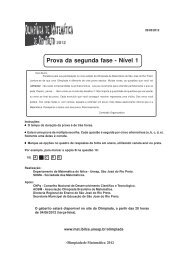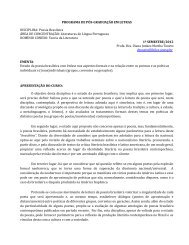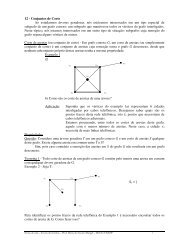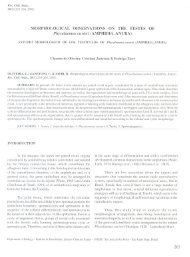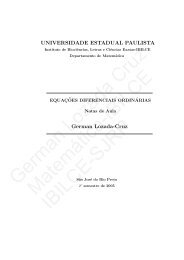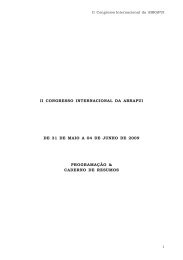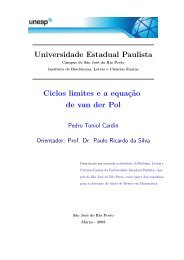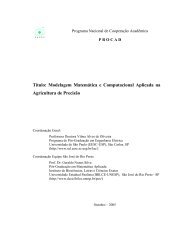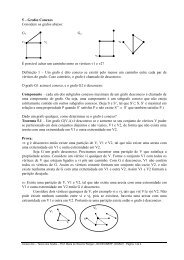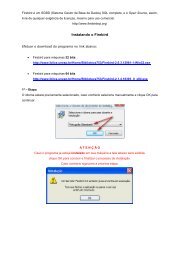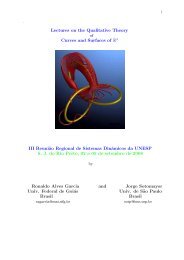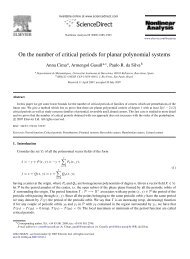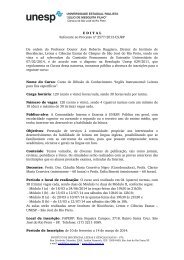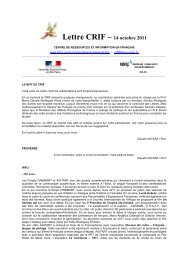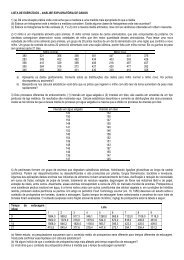Curso de Equações Diferenciais Ordinárias - Unesp
Curso de Equações Diferenciais Ordinárias - Unesp
Curso de Equações Diferenciais Ordinárias - Unesp
You also want an ePaper? Increase the reach of your titles
YUMPU automatically turns print PDFs into web optimized ePapers that Google loves.
Se β < 0 o campo <strong>de</strong> vetores é do tipo<br />
Se α < 0 a singularida<strong>de</strong> (0, 0) é chamada <strong>de</strong> FOCO ATRATOR, no sentido<br />
anti-horário se β > 0 e no sentido horário se β < 0.<br />
Se β > 0 o campo <strong>de</strong> vetores é do tipo<br />
Se β < 0 então o campo <strong>de</strong> vetores é do tipo<br />
Observe que o sinal <strong>de</strong> α <strong>de</strong>termina se a singularida<strong>de</strong> é atratora ou repulsora.<br />
Já o sinal <strong>de</strong> β está relacionado com o sentido da rotação.<br />
Exemplos on<strong>de</strong> A não está na forma canônica:<br />
1) Consi<strong>de</strong>re o seguinte sistema<br />
[ ]<br />
X ′ 1 −1<br />
=<br />
X.<br />
−2 0<br />
Seu polinômio característico é dado por p(λ) = λ 2 − λ − 2 , e as raízes<br />
<strong>de</strong>ste polinômio são 2 e −1. Os auto-vetores associados aos auto-valores são<br />
respectivamente (1, −1) e (1, 2).<br />
Consi<strong>de</strong>ramos a base formada por estes auto-vetores: B = {(1, −1), (1, 2)}.<br />
Temos então<br />
[ ]<br />
[ ]<br />
[ ]<br />
y1<br />
x1<br />
Y = = P X = P , P −1 1 1<br />
=<br />
y 2 x 2 −1 2<br />
[<br />
Y ′ = P X ′ = P<br />
Assim<br />
1 −1<br />
−2 0<br />
]<br />
X = P<br />
[<br />
1 −1<br />
−2 0<br />
(y 1 (t), y 2 (t)) = (ae 2t , be −t )<br />
]<br />
P −1 Y =<br />
(x 1 (t), x 2 (t)) = (ae 2t + b −t , −ae 2t + 2be −t ).<br />
2) Consi<strong>de</strong>re o seguinte sistema<br />
X ′ =<br />
[ 0 −2<br />
1 2<br />
]<br />
X.<br />
[ 2 0<br />
0 −1<br />
Seu polinômio característico é dado por p(λ) = λ 2 − 2λ + 2 e as raízes <strong>de</strong>ste<br />
polinômio são 1 + i e 1 − i. O auto-vetor complexo associado ao auto-valor 1 + i<br />
é (1 + i, −i).<br />
Consi<strong>de</strong>ramos a base formada pelas partes real e imaginária: B = {(1, 0), (1, −1)}.<br />
Temos então<br />
[<br />
y1<br />
]<br />
Y = = P X = P<br />
y 2<br />
[<br />
Y ′ = P X ′ 0 −2<br />
= P<br />
1 2<br />
[<br />
x1<br />
]<br />
x 2<br />
]<br />
X = P<br />
[ ]<br />
, P −1 1 1<br />
=<br />
0 −1<br />
[ ] 0 −2<br />
P −1 Y =<br />
1 2<br />
[ 1 −1<br />
1 1<br />
]<br />
Y<br />
]<br />
Y.<br />
85



